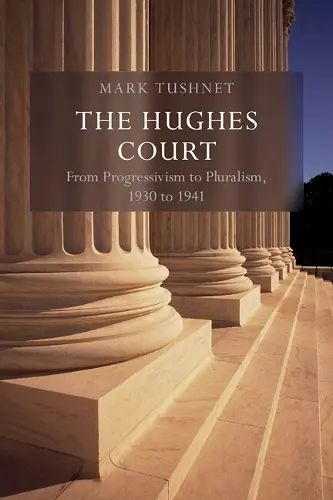The Hughes Court: Volume 11
From Progressivism to Pluralism, 1930 to 1941
Format:Hardback
Publisher:Cambridge University Press
Published:3rd Feb '22
Currently unavailable, our supplier has not provided us a restock date

A comprehensive study of the US Supreme Court that explores the transformation of constitutional law from 1930 to 1941.
This comprehensive study unpacks the claim that there was a Constitutional Revolution in 1937, instead concluding that US constitutional law gradually transformed throughout the 1930s. In combining doctrinal analysis with the political, economic and social contexts of the Court's decisions, this will interest both historians and legal scholars.The Hughes Court: From Progressivism to Pluralism, 1930 to 1941 describes the closing of one era in constitutional jurisprudence and the opening of another. This comprehensive study of the Supreme Court from 1930 to 1941 – when Charles Evans Hughes was Chief Justice – shows how nearly all justices, even the most conservative, accepted the broad premises of a Progressive theory of government and the Constitution. The Progressive view gradually increased its hold throughout the decade, but at its end, interest group pluralism began to influence the law. By 1941, constitutional and public law was discernibly different from what it had been in 1930, but there was no sharp or instantaneous Constitutional Revolution in 1937 despite claims to the contrary. This study supports its conclusions by examining the Court's work in constitutional law, administrative law, the law of justiciability, civil rights and civil liberties, and statutory interpretation.
'No one understands the politics of law better or takes the law more seriously than Mark Tushnet. With a complete mastery of the decisions of the Hughes Court, Tushnet shows us the justices as they saw themselves, professionals of disparate backgrounds, temperaments, and talents, dispatching, with the tools at hand, the disputes that ceaselessly came to them. Familiar constitutional landmarks are here, as is the high drama of Franklin D. Roosevelt's 'Court-packing' plan, but so are more gradual changes in the law of the presidency, the administrative state, the federal courts, civil liberties, and civil rights that ended with the nation on the verge of a new constitutional order. Despite economic calamity and social strife, the Supreme Court thrived, not by being above politics, but by proving its worth by doing its job.' Daniel R. Ernst, Carmack Waterhouse Professor of Legal History, Georgetown University Law Center
'In this tour de force, a master doctrinalist unpacks some of the twentieth century's most significant cases. In the process, he brilliantly unlocks the mystery of the Constitutional Revolution of 1937 that did not happen, investigates the invention of federal jurisdiction, explores the evolution of the administrative state, and illuminates the transformation of modern American liberalism. Bravo!' Laura Kalman, Distinguished Research Professor, University of California, Santa Barbara
ISBN: 9781316515938
Dimensions: 241mm x 165mm x 60mm
Weight: 2140g
1272 pages